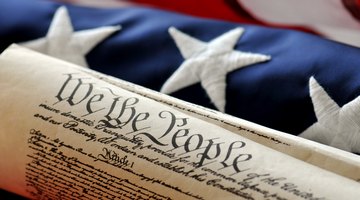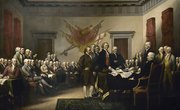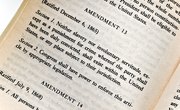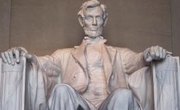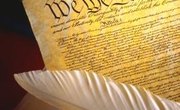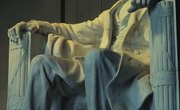At the time of the Constitutional Convention, six of the original thirteen colonies were slave-owning colonies: Delaware, Georgia, Maryland, North Carolina, South Carolina and Virginia. According to Thomas Ladenburg, author of "Making the Constitution," 25 of the 55 delegates owned slaves, including some very prominent Founding Fathers. Though the majority of delegates did not support the practice, slavery was not prohibited in the constitution for fear that would deter the six slave-owning colonies from signing on. Two years later, the issue of slavery was instrumental in the creation of distinct "states rights" and "federal rights" enumerated in the tenth amendment.
The First President
George Washington, America's first president, was one of the slave-holding delegates from Virginia. When his father died, 11-year-old Washington inherited a 280-acre farm and 10 slaves. By the time of his death in 1799 there were 318 slaves living on his Mount Vernon plantation. Though he continued to buy and sell slaves during his lifetime, Washington's ideas on the practice of slavery evolved over time. As a young man, Washington saw slave ownership as a matter of course in the ownership of a large plantation. After traveling widely during his time in the Continental Army he came to believe that slavery should be abolished in small increments. In his will, he left directions for roughly a third of his slaves to be freed. He was unable to free the rest because they belonged to a family estate that required them to be passed along to other family members.
The Third President
Thomas Jefferson, a founding father and an outspoken opponent of slavery, was another slave-holding writer of the Constitution. Approximately 130 slaves lived on his Montebello plantation at any given time. Like Washington, many of his slaves were first acquired as an inheritance. Unlike George Washington, Thomas Jefferson did not choose to emancipate his slaves upon his death. Despite his own ardent views that slavery was immoral, Jefferson believed that slavery had to be done away with bit by bit in order to prevent trouble between the races. He advocated slowly freeing the slaves and removing them from American soil to prevent a race war similar to the revolts in Haiti. During his lifetime, only two of his slaves were voluntarily given their freedom. At least three other slaves escaped to freedom without being pursued. The slaves who escaped to freedom were all descendants of a slave named Sally Hemings who is generally believed to have been Thomas Jefferson's mistress.
The Fourth President
Like President Washington and President Jefferson, James Madison was also a slave owner. And, like those presidents, many of his slaves were initially inherited as property. During the time that Madison owned and managed his Virginia plantation, Montpelier, it was home to hundreds of slaves. Montpelier continued to be supported by slave labor until after the Civil War. Believing that slavery was evil, Madison struggled with the decision of whether or not to free his slaves upon his death. He held that emancipation could not take place all at once and that, once it occurred, the two races could not coexist peacefully. For this reason, Madison believed that it would be best for freed slaves to be removed from the United States. His final decision not to free his slaves was made largely in light of the hardship it would cause for his wife, Dolley. Madison's will did stipulate that none of his slaves should be sold, "...without his or her consent" and left both money and land to the American Colonization Society -- an organization dedicated to sending free blacks back to Africa.
The First American
A legendary character in American history, Benjamin Franklin was another writer of the Constitution who owned slaves. Unlike Washington, Jefferson and Madison, Franklin did not own a huge plantation with hundreds of slaves. Instead, he owned two personal slaves -- similar to servants -- named George and King. Over time, Franklin's ideas on slavery began to shift drastically. By the end of his life, he had become a staunch abolitionist and the president of an abolitionist society. Franklin willingly gave both of his slaves their freedom long before his death in 1790.
Related Articles
References
- Emerson Kent: Map Of The United States: 1777-1785
- Digital History: Slavery, The American Revolution and the Constitution
- George Washington's Mount Vernon: Ten Facts About Washington and Slavery
- The Jefferson Monticello: Thomas Jefferson and Slavery
- The Jefferson Monticello: Enslaved Families of Monticello
- James Madison's Montpelier: Enslaved Community
- James Madison's Montpelier: Madison and Slavery
- PBS: Benjamin Franklin: Abolitionist
- Digital History: Crtical Issues and Simulations Units in American History
Resources
Writer Bio
A lifetime resident of New York, Christi O'Donnell has been writing about education since 2003. O'Donnell is a dual-certified educator with experience writing curriculum and teaching grades preK through 12. She holds a Bachelors Degree from Sarah Lawrence College and a Masters Degree in education from Mercy College.

